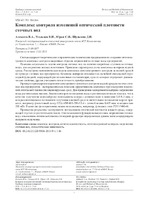| dc.contributor.author | Алексеев, В. А. | ru |
| dc.contributor.author | Усольцев, В. П. | ru |
| dc.contributor.author | Юран, С. И. | ru |
| dc.contributor.author | Шульмин, Д. Н. | ru |
| dc.coverage.spatial | Минск | ru |
| dc.date.accessioned | 2018-03-17T13:17:12Z | |
| dc.date.available | 2018-03-17T13:17:12Z | |
| dc.date.issued | 2018 | |
| dc.identifier.citation | Комплекс контроля изменений оптической плотности сточных вод = Complex for monitoring of sewage optical density changes / В. А. Алексеев [и др.] // Приборы и методы измерений : научно-технический журнал. - 2018. – Т. 9, № 1. – С. 7–16. | ru |
| dc.identifier.uri | https://rep.bntu.by/handle/data/38812 | |
| dc.description.abstract | Статья содержит теоретические и практические технические предложения по созданию оптоэлектронного комплекса контроля аварийных сбросов загрязнений в сточные воды предприятий. Показана актуальность задачи контроля сточных вод на наличие аварийных сгустков в сточных водах для сохранения водных источников. Приведена структурная схема комплекса контроля водной среды. Рассмотрена математическая модель комплекса оптоэлектронного контроля за водной средой на примере сточных вод предприятия. Комплекс контроля описывается случайной импульсной переходной функцией, содержащей две независимые составляющие, одна из которых определяет динамические свойства, другая учитывает стохастичность преобразования. Приведен пример реализации оптоэлектронного комплекса контроля водной среды в системе сточных вод предприятия. Экспериментально показана эффективность комплекса при измерении изменений оптической плотности анализируемых сред. Для проведения эксперимента выбрано загрязнение воды растительным маслом. Анализ спектров поглощения воды и растительного масла показал, что в качестве излучателя целесообразно использовать лазеры с длинами волн в диапазоне 0,4–0,5 мкм, у которых минимальное поглощение излучения в водной среде и значительное поглощение в среде примеси, например фиолетовый лазер STLL-MM-405-200-52-A с длиной волны 0,405 мкм и мощностью 200 мВт. В качестве фотоприемника можно использовать, например, фотодиод типа PDV-V400-46. Приведены результаты эксперимента исследования оптической плотности жидкой среды, содержащей сгустки из растительного масла. Они показывают функциональную связь загрязнения сточных вод с изменением оптической плотности водной среды при определенных длинах волн зондирующего лазерного излучения. | ru |
| dc.language.iso | ru | ru |
| dc.publisher | БНТУ | ru |
| dc.subject | Комплекс контроля | ru |
| dc.subject | Оптическая плотность | ru |
| dc.subject | Оптоэлектронный контроль загрязнения сточных вод | ru |
| dc.subject | Стохастическая зависимость | ru |
| dc.subject | Control complex | en |
| dc.subject | Optical density | en |
| dc.subject | Optoelectronic control of pollution of sewage | en |
| dc.subject | Stochastic dependence | en |
| dc.title | Комплекс контроля изменений оптической плотности сточных вод | ru |
| dc.title.alternative | Complex for monitoring of sewage optical density changes | en |
| dc.type | Article | ru |
| dc.identifier.doi | 10.21122/2220-9506-2018-9-1-7-16 | |
| local.description.annotation | Article contains theoretical and practical technical sentences on creation of an optoelectronic complex of monitoring of emergency discharge of pollution in sewage of the enterprises. The relevance of the task of monitoring of sewage on existence of emergency clots in sewage for saving water sources is shown. The structural scheme of a complex of monitoring of the water environment is provided. The mathematical model of a complex of optoelectronic monitoring over the water environment on the example of sewage of the enterprise is considered. The complex of monitoring is described by the random impulse transition function containing two independent components, one of which defines dynamic properties, another considers stochasticity of conversion. The example of implementation of an optoelectronic complex of monitoring of the water environment in the system of sewage of the enterprise is given. Experimentally the efficiency of a complex in case of measurement of changes of optical density of the analysable environments is shown. For carrying out an experiment water pollution is selected by vegetable oil. The analysis of absorption spectra of water and vegetable oil showed that as a source of radiation it is expedient to use lasers with lengths of waves in the range of 0,4–0,5 μm which have the minimum absorption of radiation in the water environment and the considerable absorption in the environment of impurity, for example, the violet STLL-MM-405-200-52-A laser with wavelength of 0,405 μm and 200 mW. As the photo-sensor element, it is possible to use, for example, the PDV-V400-46 photodiode. Results of an experiment of a research of optical density of the liquid environment containing clots from vegetable oil are given. They show the functional connection of pollution of sewage with change of optical density of the water environment with certain lengths of waves of a probing laser radiation. | en |

